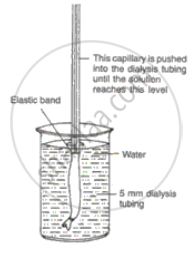Advertisements
Advertisements
प्रश्न
The apparatus arranged alongside signifies an important process.
(i) Name the process.
(ii) Where does this process occur in plants?
(iii) What solution is placed inside the dialysis tubing?
(iv) What happens to the level of the solution in the capillary tube?

उत्तर
(i) Osmosis
(ii) Root hair
(iii) Sugar solution
(iv) The level of the liquid in the capillary tube rises.
APPEARS IN
संबंधित प्रश्न
The diagram of an given below demonstrates a particular process in plants. Study the same and answer the questions that follow :

(i) Name the apparatus.
(ii) Which phenomenon is demonstrated by this apparatus?
(iii) Explain the phenomenon mentioned in (ii) above.
(iv) State two limitations of using this apparatus.
(v) What is the importance of the air bubble in the experiment?
(vi) Name the structures in a plant through which the above process takes place.
Name the following:
The process by which water enters root hairs.
The diagram given below represents the results of an experiment conducted on two freshly taken leafy shoots of a herbaceous plant. The lower ends of the shoots dip in ordinary water.
(i) What is the aim of the experiment?
(ii) Some parts of the stem in both the shoots have been removed. Name the conducting tissue in shoot (a) and in shoot (b) that has been removed.
(iii) What are the results of this experiment?

The alongside diagram A shows a root hair growing through the soil particles. Diagram B is the root hair of an aquatic plant.
(i) Name the parts 1,2,3.
(ii) Name two substances which enter the root hair. What are their uses?
(iii) By what process do these substances enter the root hair?
(iv) Account for the different shapes of root hairs in the two diagrams.
What would happen to the leaves of a plant that transpires more water than its absorption in the roots?
Epiphytic plants like orchids absorb water vapours from air with the help of epiphytic roots having special tissue called ____________.
Why and how does water enter continuously into the root xylem?
They are pipe-like, consisting of a group of specialised cells. They transport substances and form two-way traffic in plants. Which of the following terms qualify for the features mentioned above?
Water in the root enters due to ______.
